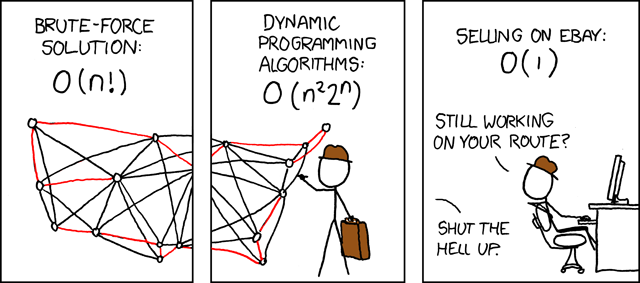Saturday, December 10, 2011
Thursday, December 8, 2011
Reverse the direction of each pointers of Linked List which haveing next & random pointer with it.
Consider a Linked List with each Node, in addition to having a 'next'
pointer also has a 'random' pointer. The 'random' pointer points to
some random other Node on the linked list. It may also point to NULL. To
simplify things, no two 'random' pointers will point to the same node,
but more than 1 Node's random pointer can point to NULL.
Now we are required to reverse the direction of all the pointers (both the 'next' and 'random') of the Linked list. The constraint is the solution MUST be O(1) space complexity (A constant number of new nodes can be created but not proportional to the length of the list)
Now we are required to reverse the direction of all the pointers (both the 'next' and 'random') of the Linked list. The constraint is the solution MUST be O(1) space complexity (A constant number of new nodes can be created but not proportional to the length of the list)
Labels:Data
Amazon Interview
Wednesday, December 7, 2011
Find The Largest Binary Search Tree in GIven Tree . Its Should be the Subtree.
Very Faq. Asked Question All Tech Giants :) Will Post The Solution Soon :) Meanwhile You Can Try & Post the approach .
Prerequisite : Most Efficient Solution to Check if Given Tree is BST or not ? !st Try it or Search Archives :)
Basic Idea :
Traverse the tree. From each node to the parent, return the following
set of values.
1) If BST, size of the current BST or -1 if the tree is not.
2) Minval & Maxval of the subtree and maxbstsize seen so far (
probably using references)
So in each node check the following:
set of values.
1) If BST, size of the current BST or -1 if the tree is not.
2) Minval & Maxval of the subtree and maxbstsize seen so far (
probably using references)
So in each node check the following:
If( leftmax < node->data && node->data < rightmin) // Means it is a BST
{
new size = rightsize+leftsize+1
update size if greater than max
return size
}
else
{
return -1;
}
Working Code:
/* Largest Binary search tree inside a binary tree -- O(n)*/
#include <stdlib.h>
#include <stdio.h>
using namespace std;
struct node
{
int data;
struct node* left;
struct node* right;
};
struct node* insert_bst(struct node* root, int num){
if(root == NULL){
root = (struct node*)malloc(sizeof(struct node));
root->data = num;
root->left = NULL;
root->right = NULL;
return root;
}else{
if(num == root->data){
return root;
}
if(num > root->data){
root->right=insert_bst(root->right,num);
}else{
root->left=insert_bst(root->left,num);
}
}
return root;
}
void inorder_traverse(struct node* root){
if(root == NULL) return;
inorder_traverse(root->left);
printf("%d ",root->data);
inorder_traverse(root->right);
}
struct node* bst_root = NULL;
int getmaxbst(struct node* root, int& subtreemin, int &subtreemax, int& max)
{
if(root == NULL) return 0;
int leftsubtreemin = -32767, rightsubtreemin = -32767;
int leftsubtreemax = 32767, rightsubtreemax = 32767;
int x,y;
x = getmaxbst(root->left, leftsubtreemin, leftsubtreemax, max);
y = getmaxbst(root->right, rightsubtreemin, rightsubtreemax, max);
if(x==-1 || y ==-1)
return -1;
if(x==0) { leftsubtreemax = root->data; leftsubtreemin = root->data;}
if(y==0) { rightsubtreemin = root->data; rightsubtreemax = root->data;}
if(root->data < leftsubtreemax ||
root->data > rightsubtreemin){
return -1;
}
subtreemin = leftsubtreemin;
subtreemax = rightsubtreemax;
if(x+y+1 > max){
max = x+y+1;
bst_root = root;
}
return x+y+1;
}
int main()
{
struct node* root=NULL;
root=insert_bst(root,5);
root=insert_bst(root,3);
root=insert_bst(root,9);
root=insert_bst(root,7);
root=insert_bst(root,4);
root=insert_bst(root,1);
root=insert_bst(root,14);
root=insert_bst(root,11);
root->data = 0;
int a,b,c,max=-32767;
c = getmaxbst(root,a,b,max);
printf("\nmax is %d\n",max);
inorder_traverse(bst_root);
return 1;
}
TC O(N)
SC O(1)
Labels:Data
Adobe Question
,
Amazon Interview
,
Google Interview
,
Trees
Wednesday, November 30, 2011
Tuesday, November 29, 2011
Subscribe to:
Comments
(
Atom
)



